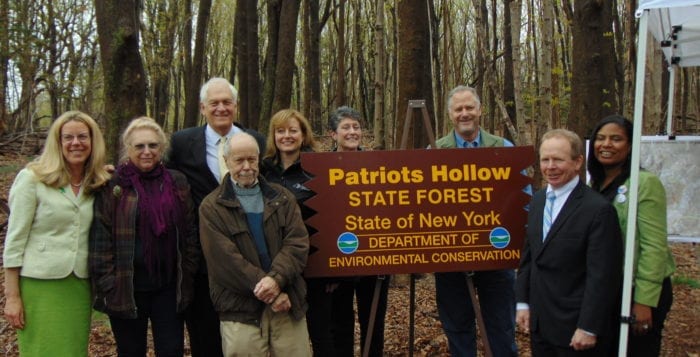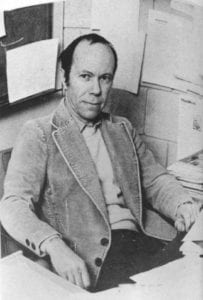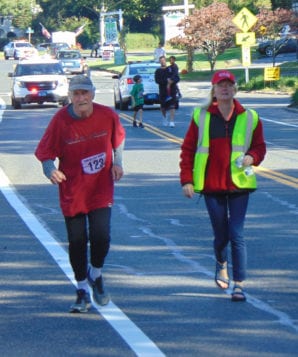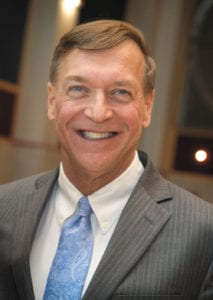For one Eagle Scout, earning coveted merit badges has been more than a pastime; it’s been a mission. The undertaking has led him to earn all 137 badges a Scout can receive — an accomplishment only 6 percent of scouts in the nation have achieved, according to the Boy Scouts of America website.
John Ninia, of Poquott, a senior at Ward Melville High School, moved up from Cub Scout to Boy Scout when he was 11 years old. Ninia said it took him six years to earn all 137 badges. A scout needs 21 badges to become an Eagle Scout — 16 being mandatory ones.
“I just went for all of them,” the Troop 70 Eagle Scout said.
When he was 12 years old, Ninia said he attended Boy Scout camp, where his mission to collect every badge first became his goal.

“I remember after my first week of summer camp, I was on my way home and I was really thrilled,” he said. “Usually you can get five badges if you’re really into it but I got about 11, and my parents mentioned that I could go back for a second week.”
Ninia said he immediately signed up for the second week, and when he earned 20 badges that summer, he said it was a great feeling. The Scout said some merit badges, such as one for art, can take a day and a half, while personal fitness, family life and other badges require more time, even months. He said a scuba badge took several days of training to earn certification, while achieving the water skiing one was the most difficult, but he kept trying until he could stand up on the skis.
Ninia completed three Hornaday projects, which are tasks that involve the environment. He eliminated invasive knotweed, a Japanese plant, at West Meadow Beach, planted trees at Frank Melville Memorial Park and installed a rain garden in the Village of Poquott’s California Park. Working to improve the environment is a passion of his, and he plans to major in environmental studies in college.
Frank Melville Memorial Foundation Park Board President Robert Reuter said Ninia worked diligently to clear a substantial vine-choked area adjacent to the Bates House in the park. His work saved existing trees and allowed for the planting of several native white flowering dogwoods.
“It’s revealing of his commitment that I get calls from John offering to continue the work,” Reuter said. “This young man has a bright future underpinned by his extraordinary personal achievements and service to community.”
Robert Mandell, who was Ninia’s troop leader for the majority of the time he has been in Boy Scouts, said he remembers the teenager coming to him telling him how he earned badges for various activities such as glass blowing and concrete mixing. The former troop leader he said he would question him at length about what he did to earn the badge.
“I quizzed them like the FBI,” Mandell said.
He said he wasn’t surprised when Ninia earned every badge, saying he is a smart, hardworking teenager.
“This young man is driven,” the former troop leader said.
While the experiences earning the badges have provided great memories for Ninia, he said what he has enjoyed most during his Scouting years has been “providing leadership to a group of scouts and helping them with their own ability to rank up.”
“This young man has a bright future underpinned by his extraordinary personal achievements and service to community.”
— Robert Reuter
Despite a busy schedule with school, the cross-country team and DECA, Ninia said it’s important to make time for Scouting.
The high school senior said one can no longer be a scout after 18, but while his days as a scout may be over soon, he hopes to always be a part of the organization in some way, even though he’s not sure about being a troop leader.
“It’s hard, and I do have a lot of stuff and I’m a busy guy, but Scouting is something I’ve loved so I’ve always been able to make time for it,” he said. His advice to other Scouts? “Try your best and shoot for the stars.”
Ninia’s father Jerry said the family, which includes mom Lynn and siblings James and Christina, is proud of their Scout and his accomplishments.
“He’s a good kid,” his father said. “He works very hard He perseveres. He has a can-do attitude. He’s just the kind of guy that makes things happen.”
Achieving merit badges makes a Scout a more well-rounded individual, according to Jerry Ninia.
“When you think about it, 137 merit badges, it touches on everything from art to architecture to woodworking to metalworking to horseback riding to law and medicine to water sports and everything in between,” he said. “You can probably strike up a conversation with anyone as a young adult and speak to anyone from practically any walk of life because you’ll probably feel some commonality.”








 How would you describe “How Now, Ms. Brown Cow?” to someone who hasn’t read it?
How would you describe “How Now, Ms. Brown Cow?” to someone who hasn’t read it? 



























